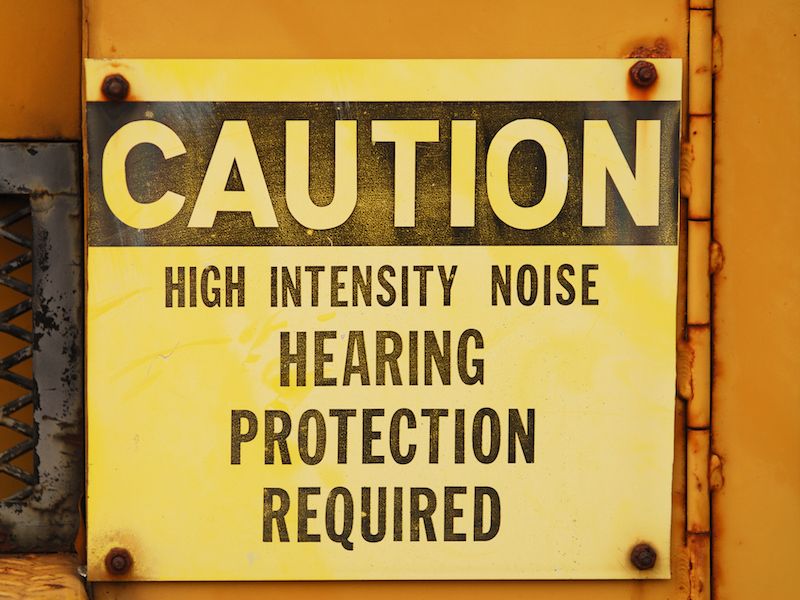
It’s one thing to realize that you should safeguard your ears. Knowing when to safeguard your ears is another matter. It’s more difficult than, let’s say, recognizing when you need sunscreen. (Is the sun out and will you be outdoors? Then you need sunblock.) Even knowing when you need eye protection is simpler (Handling hazardous chemicals? Doing some building? You need to wear eye protection).
It can feel like there’s a significant grey area when addressing when to wear hearing protection, and that can be detrimental. Unless we have specific knowledge that some activity or place is dangerous we tend to take the easy road which is to avoid the problem altogether.
Determining The Risks
In general, we’re not very good at assessing risk, especially when it comes to something as intangible as damage to the ears or the probability of long term sensorineural hearing loss. To prove the point, check out some examples:
- A very loud rock concert is attended by person A. 3 hours is approximately the length of the concert.
- A landscaping company is run by person B. After mowing lawns all day, she goes home to quietly read a book.
- Person C works in an office.
You may think the hearing danger is greater for person A (let’s just call her Ann). Ann leaves the performance with ringing ears, and she’ll spend the majority of the next day, struggling to hear herself talk. It seems reasonable to assume that Ann’s recreation was very hazardous.
Person B (let’s call her Betty), on the other hand, is subjected to less noise. There’s no ringing in her ears. So her ears must be less hazardous, right? Not necessarily. Because Betty is mowing all day. So although her ears don’t ring out with pain, the damage accrues gradually. Even moderate noises, if experienced with enough frequency, can injury your hearing.
What’s going on with person C (let’s call her Chris) is even harder to make sense of. Lawnmowers have instructions that emphasize the risks of ongoing exposure to noise. But despite the fact that Chris has a fairly quiet job, her long morning commute through the city each day is rather loud. Additionally, she sits at her desk and listens to music through earbuds. Is protection something she should think about?
When You Should Worry About Safeguarding Your Ears
The general guideline is that if you have to raise your voice to be heard, your surroundings are loud enough to do damage to your ears. And you really should think about using earmuffs or earplugs if your environment is that loud.
The cutoff needs to be 85dB if you want to get scientific. Sounds above 85dB have the ability, over time, to result in damage, so in those situation, you need to think about wearing ear protection.
Your ears don’t have a built-in sound level meter to warn you when you get to that 85dB level, so most hearing professionals suggest downloading special apps for your phone. These apps can inform you when the surrounding sound is nearing a dangerous level, and you can take proper steps.
A Few Examples
Even if you do download that app and bring it with you, your phone might not be with you wherever you go. So we might develop a good baseline with a couple of examples of when to protect our ears. Here we go:
- Commuting and Driving: Spending all day as an Uber or Lyft driver? Or perhaps you’re riding the subway after waiting for a while downtown. The noise of living in the city is bad enough for your hearing, not to mention the extra damage caused by turning up your music to drown out the city noise.
- Listening to music with earbuds. OK, this doesn’t require protection but does require care. Whether your music is playing directly into your ears, how loud it is playing, and how long you’re listening to it are all things you should give consideration to. Noise-canceling headphones are a good choice to prevent having to turn the volume way up.
- Operating Power Tools: You recognize that working all day at your factory job is going to require hearing protection. But how about the hobbyist building in his workshop? Even if it’s just a hobby, hearing specialists suggest wearing hearing protection if you’re working with power equipment.
- Exercise: Your morning spin class is a perfect example. Or perhaps your daily elliptical session. All of these examples might require hearing protection. Those instructors who make use of sound systems and microphones (and loud music) to motivate you may be good for your heart rate, but all that volume is bad for your ears.
- Household Chores: We already discussed how something as basic as mowing the lawn, when done often enough, can require hearing protection. Chores, such as mowing, are probably something you don’t even think about, but they can result in hearing damage.
A good baseline might be researched by these examples. If there is any doubt, however, wear protection. Rather than leaving your ears exposed to future harm, in most situations, it’s better to protect your hearing. If you want to be able to hear tomorrow, protect today.